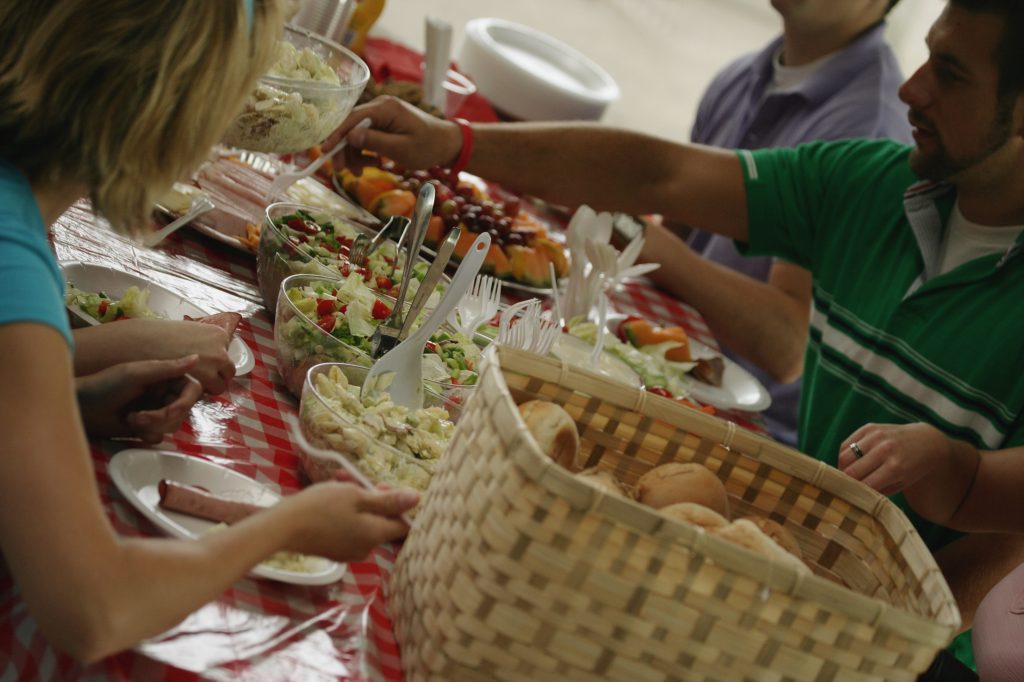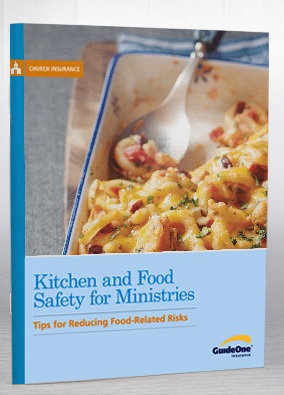
In November 2016, three people reportedly died from food-poisoning, and an additional 22 got sick after eating a free, annual Thanksgiving feast, which was served by a church in the San Francisco Bay Area.
Did you know that more than 48 million people get sick and nearly 3,000 people die from foodborne illnesses in the United States each year?1 Having proper food handling procedures in place is pivotal in helping minimize food risks.
With summer cookouts and community potlucks right around the corner, ensure your church has a written policy regarding food preparation / food safety in place and that all employees and / or volunteers who work in your kitchen are receiving training on these procedures.
Food preparation
- Wash cutting boards, dishes, utensils and counter tops with hot, soapy water before and in between using each food item.
- Use one cutting board for produce and a separate board for meat and poultry to reduce the risk of salmonella and other bacteria-causing illnesses. Using different-colored cutting boards for different food items will help reduce cross contamination.
- Separate raw, cooked and ready-to-eat foods while shopping, preparing or storing. Never place cooked food on a plate that previously held raw meat, poultry or seafood.
- Marinate meat, seafood and poultry in the refrigerator in a covered, non-metallic container.
- To properly thaw frozen meat, it’s best to plan for slow, safe thawing in the refrigerator. Allow about one day for every 5 pounds of meat to thaw in the refrigerator.
According to research by the United States Department of Agriculture (USDA), one out of every four hamburgers turns brown before it reaches a safe internal temperature. The only safe way to know if meat, poultry and egg dishes are done is to use a food thermometer. Below are USDA recommended safe minimum internal temperatures, measured with a food thermometer:
- Whole cut meat; beef, veal, lamb and pork — 145 degrees Fahrenheit (allow meat to rest for at least 3 minutes before carving or consuming)
- Ground meat; beef, veal, lamb and pork — 160 degrees Fahrenheit
- All poultry (whole and ground) — 165 degrees Fahrenheit
- Egg dishes — 160 degrees Fahrenheit
- Fish — 145 degrees Fahrenheit
- Ground beef — 160 degrees Fahrenheit
- Pork — 160 degrees Fahrenheit
- Poultry, whole and chicken breasts — 165 degrees Fahrenheit
- Steaks and roasts — 145 degrees Fahrenheit
- Do not serve home-canned foods. Most outbreaks of food-borne botulism are caused by home-canned foods.
Food serving
- When hosting a buffet, do not mix new food with existing food.
- Food should not be left out at room temperature for more than two hours (one hour if over 90 degrees Fahrenheit outside). Remember, many food brought from home will already have been out for a significant period of time.
- Hot foods should be refrigerated within two hours after cooking.
- Reheat leftovers to 165 degrees Fahrenheit or above. Food should be reheated only once.
- When being served, hot foods should be kept at 140 degrees Fahrenheit or above, and cold foods at 40 degrees Fahrenheit or below. (A log should be kept of when and who checked temperatures.)
- Separate utensils should be used for each food item during cooking and serving.

Food Storage
- Most refrigerated leftovers should be used in three to five days.
- Don’t ever taste food to check for freshness. When in doubt, throw it out.
- If using coolers, food should only be consumed if there is still ice in the cooler and the food is cooled to refrigerator temperature.
- Refrigerator temperatures should range from 34 to 40 degrees Fahrenheit (1 to 3 degrees Celsius). Foods spoil rapidly above 40 degrees Fahrenheit (3 degrees Celsius).
- The best temperature for frozen food storage is at 0 degrees Fahrenheit (-17 degrees Celsius). The temperature should not reach higher than 5 degrees Fahrenheit (-15 degrees Celsius).
- Refrigerator and freezer temperatures should be periodically checked and a log kept of when and who checked temperatures.
Kitchen sanitation
- An agreement with a professional pest control service should be in place for the kitchen area. This is not a service that should be provided by inexperienced staff members or volunteers.
- Mechanical dishwashing equipment should be in good repair, and temperature gauges should be monitored and documented.
- Garbage containers should be located an adequate distance away from the building.
- Appropriate sanitizing solution should be used in correct concentrations. Bleach is not approved for sanitizing food contact surfaces.
- Employees and / or volunteers handling food should wash their hands frequently and correctly, should not use aprons or towels to dry hands after washing, and should not handle, prepare or serve food if they have an apparent illness.
Make your kitchen safer
By following these recommended food safety tips, not only will you make your kitchen safer, but you could prevent the possibility of an accidental case of food poisoning or something worse from occurring. Read more about food and kitchen safety in GuideOne’s e-book.
Eric Spacek, JD, ARM is the Director of Risk Management and Loss Control at GuideOne Insurance in West Des Moines, IA. Before joining GuideOne, he served as Minister of Operations for a large Methodist church in Raleigh, NC, and was a liability litigation trial attorney in Washington, D.C.
1 Center For Disease Control


